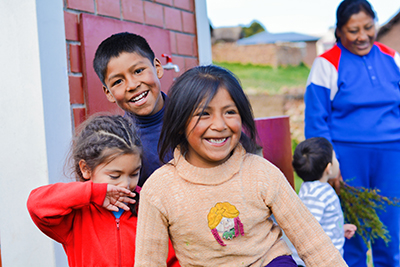A victory for Native children's rights to remain with family and tribe
Posted on October 30, 2020
 Forty-two years ago, Congress enacted the Indian Child Welfare Act to address a centuries-long practice: Removal of Native American children from their families and tribes by government actors and private agencies. When the welfare act was passed into law, a staggering number of Native children — in some states, as many as one in three — had been separated from their families and tribal communities. Washington State was one of the worst offenders. Native children were taken from their families and tribes without notice or explanation. The wholesale removal of Native children destroyed families and posed an existential threat to tribes.
Forty-two years ago, Congress enacted the Indian Child Welfare Act to address a centuries-long practice: Removal of Native American children from their families and tribes by government actors and private agencies. When the welfare act was passed into law, a staggering number of Native children — in some states, as many as one in three — had been separated from their families and tribal communities. Washington State was one of the worst offenders. Native children were taken from their families and tribes without notice or explanation. The wholesale removal of Native children destroyed families and posed an existential threat to tribes.
The child welfare act was designed to protect Native children from separation from their families and tribes — and by keeping them within their tribal communities, safeguard the very existence of tribes. The statute achieves these aims by requiring that tribes be notified whenever there is “reason to know” that an Indian child is subject to a child welfare proceeding and by granting tribes the right to intervene in such cases. The statute also imposes heightened standards for removing Native children and terminating parental rights, and establishes a strong mandate for placing children who must be removed with relatives or other tribal members. Tribal notice is essential to the act’s efficacy. Without such notice, a tribe would be powerless to protect its interests and the interests of the child and family.
A recent, unanimous opinion of the Washington State Supreme Court authored by Justice Raquel Montoya-Lewis, the first Native American justice to serve on the court, gives critical life to the rights granted under the act by giving expansive meaning to the “reason to know” standard that invokes its protections.
Now, whenever any participant in an involuntary child-welfare proceeding indicates that a child has Indian heritage, the act’s protections are triggered and must be applied. The act requires that courts ask each participant in a child-custody proceeding whether there is “reason to know” the child is or may be an Indian child. The Supreme Court’s decision clarifies that if there is any indication from any participant that a child has Indian heritage — for example, testimony from a social worker, parent or intervening tribe — the act’s protections must be applied.
This broad interpretation ensures that tribes — not social workers or judges — determine whether children are eligible for membership and thus preserves tribes’ sovereign role in determining eligibility. This expansive application of ICWA is particularly important given the harm that led to the act’s passage: America was so successful in destroying Native families that many people lack knowledge of their own Native descent. Without notice to tribes, untold numbers of Native children would be denied protections under the act.
The 9-0 ruling reminds us of the 300-year trauma inflicted on Native families and its lasting impact. And Justice Montoya-Lewis tells that history through the voices of those who lived it, quoting Congressional testimony of survivors about the trauma of separation. That trauma persists. As of 2015, Justice Montoya-Lewis notes, American Indian and Alaskan native children in our state were represented in foster care at a rate 3.6 times higher than their representation in the general child population — well above the national average. National research suggests that one in seven Native American children will enter foster care before they turn 19*. The damage to these children is real. An overwhelming body of research demonstrates that separation from families is one of the most significant traumas a child can experience. We know that Native American children who are eventually adopted away from their tribe suffer more serious mental-health issues than white adoptees.
In preserving the right of tribes to protect their children from wrongful removal, the Supreme Court not only advanced the wellbeing of tribes, whose very existence continues to be threatened by removal of their children, it promoted the well-being of Native children. Placement of children with extended family and within their tribe, as the act prescribes, significantly reduces the trauma of separation, promotes stability, improves behavioral and health outcomes, and preserves cultural identity and community connections.
Centuries of state-sponsored separation of Native children left an indelible stain on our state and our nation. Our Supreme Court has rightly decreed that the protections enacted to prevent this wrong must be zealously enforced.
Kitty-Ann van Doorninck is a Pierce County Superior Court judge.
Helen Halpert is a retired King County Superior Court judge.
Ron J. Whitener is a retired chief judge of the Tulalip Tribes.
@---------------------------@
*Abstract
Foster care placement is among the most tragic events a child can experience because it more often than not implies that a child has experienced or is at very high risk of experiencing abuse or neglect serious enough to warrant state intervention. Yet it is unclear how many children will experience foster care placement at some point between birth and age 18. Using synthetic cohort life tables and data from the Adoption and Foster Care Analysis and Reporting System (AFCARS), we estimated how many U.S. children were placed in foster care between birth and age 18, finding support for three conclusions. First, up to 5.91% of all U.S. children were ever placed in foster care between their birth and age 18. Second, Native American (up to 15.44%) and Black (up to 11.53%) children were at far higher risk of placement. Foster care is thus quite common in the U.S., especially for historically disadvantaged racial/ethnic groups. Third, differences in foster care placement were minimal between the sexes, indicating that the high risks of foster care placement are shared almost equally by boys and girls.
Citation: Wildeman C, Emanuel N (2014) Cumulative Risks of Foster Care Placement by Age 18 for U.S. Children, 2000–2011. PLoS ONE 9(3): e92785. https://doi.org/10.1371/journal.pone.0092785
Editor: Monica Uddin, Wayne State University, United States of America
SEE ALSO:
More Race Relations Articles
Sexual Bias Articles
Mental Health Articles
How Drugs and Alcohol Affect the Brain and Body
WA. Counselor Directory: find a therapist near you
How helpful is this web page to you?
(and how can we can improve this page for you?)
not helpful
very helpful
Other Articles
Race in America: policing, kneeling
Letters to the Editor, Northwest Voices, Opinion
Change policy culture “How police unions became such powerful opponents of change” [June 6, Nation), misses options to change police culture before officer contact with a union. The polic... read more
Yes - I was hired because I was Black. But that is not the only reason.
In a 10-part series, Michelle Singletary gets personal about misconceptions involving race. Here, she examines the notion that affirmative action gives unqualified Black people an unfair advantage. ... read more
Are American racial truths a threat to Trump?
“I didn’t know.” Those were the first words my friend, a white guy named Dave, spoke to me the day after the first episode of “Roots,” which depicted the capture and enslave... read more
How history has led to an extraordinary moment
Aaron Dixon has seen a lot in his 71 years. The leader of Seattle’s Black Panther Party in the height of the turbulent 1960s, Dixon lived through the uprisings after the murder of the Rev. Dr. Martin L... read more
What will come of the wreckage of a divided America?
It's in our hands
Several weeks ago, I found myself straddling the centerline of a rural highway, kneeling on hot asphalt, aiming a charged fire hose at the aftermath of a head-on collision. Neither car was yet burning, but f... read more






